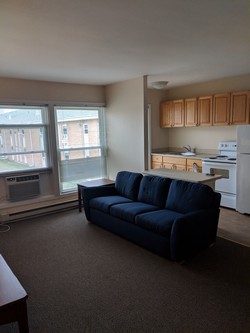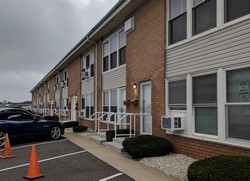Asbestos-Containing Minerals (ACMs), chemicals that can be toxic when released into the air, were discovered in small amounts at the University’s off-campus Bluffs Apartments during a renovation of the buildings this summer.
“A minimal amount of asbestos was identified in the kitchen and hall tiles, and the spackle,” said Patricia Swannack, Vice President of Administrative Services, who is responsible for the maintenance and care of facilities at the University.
According to Swannack, the renovations included replacement of flooring, doors, kitchen cabinets, counters, and furniture as well as upgrading bathrooms.
“Before the University begins invasive work, such as removing floor tiles, sheetrock, or taping, we request that our independent environmental company perform an evaluation to determine whether any suspect material contains asbestos,” said Swannack. “Our employees have been trained to identify materials that may contain asbestos if disturbed. For example, floor tiles that contain asbestos are not harmful unless they are disturbed. We routinely test any material that we think may be suspect.”
According to the Agency for Toxic Substances and Disease Registry (ATSDR), asbestos is a term referring to a class of minerals that includes amosite, chrysotile, and anthophyllite. These minerals naturally form long, thin strong fibers. The ATSDR states that individuals may be exposed to asbestos by inhaling these fibers found in the air, swallowing the fibers, or touching through contact with skin. Asbestos fibers can aggravate the lung tissue and cause scarring, which can have side effects ranging from breathing problems to lung cancer.
 Swannack maintains that severe lasting effects of asbestos exposure is unlikely. “The minimal amount of asbestos found was abated,” she said. “The air was retested and we were advised by the engineering firm that it was safe to enter the building.”
Swannack maintains that severe lasting effects of asbestos exposure is unlikely. “The minimal amount of asbestos found was abated,” she said. “The air was retested and we were advised by the engineering firm that it was safe to enter the building.”
“Asbestos containing materials (ACM) that are friable (easily crumbled) have a much greater tendency to release fibers into the air,” she explained. “Conversely, non-friable asbestos containing materials such as floor tiles and siding, because of their nature, do not easily release their fibers into the air,” she continued. “The most common construction materials which contain asbestos are floor tiles, roofing and siding, which are very strong and don’t readily crumble or release asbestos fibers unless they are subjected to strong forces.”
While asbestos is deadly, the onset of symptoms may not appear for a number of years. Kathy Maloney, Director of Health Services, said that there are clinical symptoms that may take 15 to 30 years to develop post-exposure.
Swannack provided clarity on the asbestos levels at the apartments. “Asbestos is a health risk when it is friable, that is, when it is crushed, pulverized or reduced to powder, and present in air that is breathable,” Swannack said. “That is not and has not been the case when an asbestos abatement was performed at the Bluffs.”
Jeremy Colon, a senior and criminal justice student, was living at the apartment where the ACMs were discovered and said that he was never notified about the asbestos. “I personally found out from a sign that was on the outside of the building during renovations in the summer, a sign that was meant to keep strangers and workers safe,” said Colon.
Kaitlin Korgeski, a senior communication student, is another resident who was living at the Bluff Apartments over the summer. Like Colon, Korgeski was not informed of the situation. “I think the University was hoping to keep the situation quiet, especially since they cleaned it during the summer when there are less students living at the bluffs,” she said. “However, I was living at the Bluffs this summer and I witnessed the entire building being quarantined and people in hazardous suits only being allowed into the apartments. For the school to not even notify students of the danger is very concerning.”
“[The University officials] claim they didn’t discover (asbestos) until this summer when they were doing a little remodeling,” Korgeski commented. “Once they began to remodel and move things around, that’s when they disturbed it and discovered asbestos. But still there was no word about it.”
Swannack weighed in on students’ claims that they weren’t notified. “Students moved out in May and returned in August,” she said. “All work was performed while the building was vacant during the summer,” she continued. “We are required to notify occupants when they are living in the apartment,” noted Swannack. “We did not abate any asbestos in any occupied apartments so there was no one to notify.”
Colon was moved out of the apartment with the ACMs into another Bluff’s Apartment. “The only reason I didn’t [permanently] leave was because of the convenience between classes and where I work [at Rook Coffee],” said Colon.
Korgeski spoke candidly about the lasting effects that she and other students may endure from their time living in the Bluff’s during the asbestos discovery. “I am worried about any possible exposure to asbestos that I could be receiving,” she said. Korgeski continued, “It will be many years from now, but that exposure can cause serious health problems and can be deadly.”
Korgeski is still living at the Bluff’s, but only for financial purposes. “I can’t afford an apartment where I have to pay every month. With the Bluffs, it’s in student loans,” she said.
PHOTOS TAKEN by Zach Cosenza




